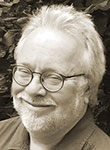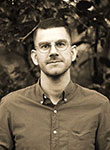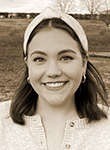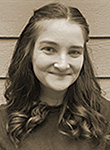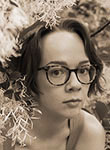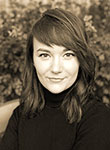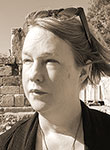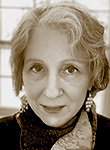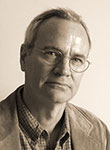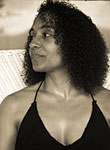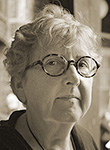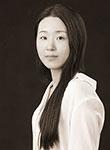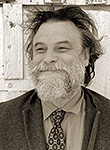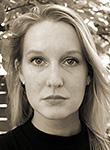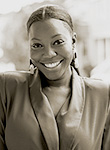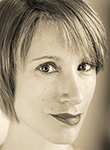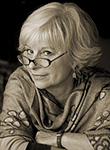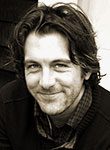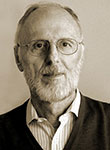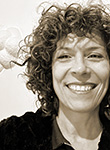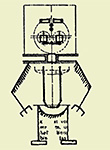Blackbird v21n3 marks a transition for the journal as new editors are planning for a fresh design and a reimagined staffing model that will launch in the fall.
In saying goodbye, the founding editors cannot stress more strongly the honor and privilege it has been to present the work of so many gifted and crucially important writers, and we thank them all so very, very much.
Since we began imagining the shape of Blackbird in the fall of 2001, the world around us has seemed to shift with great regularity. It has been spinning as if it wants to throw us off and ditch us altogether as it mimics the Tilt-a-Whirl or a Rotor ride at a carnival or state fair, tossing us all one way or another and then letting the bottom fall out. We are left relying only on our trust in centrifugal force to tie us to the world we think we know.
Therefore, we have found great solace in the work that we have published, watching as the creative impulse yet again undertakes to stand against an approaching darkness.
In a stellar essay on the work of Robert Hayden, David Wojahn reflects on Hayden’s life to chronicle how an insistent “outsiderhood,” determined by persistent racism and domestic violence, recurs in the poet’s work as he uses his art to aim for a path that can offer some surcease from both. Wojahn, most importantly, emphasizes why that art, in fact why all art, holds us as a force that can outstrip even gravity, articulating that while we may be “haunted by our inhumanity,” we can refuse “to entertain the notion that our brutality to one another can ever prevail.”
Wojahn concludes his essay by noting: “How could someone find the means to continue, if only tentatively and provisionally, to believe in America’s promise after so much evil had been done, not just on January 6, but for hundreds of years beforehand? It was then, after scanning my bookshelf with something like desperation, I found the poem that gave me something like an answer. That poem was entitled ‘[American Journal],’ and its author was Robert Hayden.”
So here, once again, is our offering of the news we can find in poems—or in stories, and thank you for being companions along the way.
Each spring, Blackbird’s Introductions Reading Loop recognizes new artists of note whose work strikes us as exceptionally fine and full of promise. Joining this company for 2023 are Colin Bailes, Hayley Graffunder, Danielle Kotrla, Rebecca Poynor, Waverley Vesely, Caitlin Wilson, and Brandon Young, seven poets who have served as Blackbird editors and whose work merits any reader’s attention.
Colin Bailes’s poetry, imbued with imagery drawn from nature, reflects on the precariousness of life, the pressures of growth, and the passing of time. “Between the Fields of Then and Now” and “Nostos” are meditations on change in which the natural world becomes a refuge for introspection. Having delved into the terrain of the self, the speaker reflects, “I never expected to come this far.”
In her poems “Like Riding a Bike” and “Relic,” Hayley Graffunder reflects on a sharply formative childhood memory and equally vivid loss. In “Relic,” the speaker seems to be suspended in their own history; “the way I will never be anything but ten,” Graffunder tells us. The past haunts these poems as a relic itself as the speaker attempts to face and separate memory’s invasive presence.
Danielle Kotrla’s poems “Azimuth” and “Bluebonnets” elicit feelings of grief and tenderness through the presence of a beloved but aging dog, and Kotrla writes in “Bluebonnets,” “I learned / losing sight of him meant that the field was thriving.” Flowers become symbols for the emotions that accompany the speaker’s relationship to the dog and, more strikingly, the slow loss of it.
Set in the Deep South, Rebecca Poynor’s poems examine subtle variations of violence as navigational aids to the complexities between place and the self. Deeply woven elements of social, personal, and scientific narratives filter the speaker’s experience. The natural world is omnipresent and haunting. In “Windowless Place,” Poynor writes, “My brother / holds my hand loosely; the idea / of protection is enough like safety.”
Waverley Vesely uses the ekphrastic form as a vehicle for investigating assumptions and puzzles of perception and gender. On John Singer Sargent’s painting and repeated revision of Portrait of Madame X, Vesely writes, “This was the way a body makes a person in / the eyes. The way it wants to separate from / meaning . . . ” These poems examine the complex relationship between visibility and body—underlining how incapable we are of truly seeing an other.
“Friction devises this hollow form,” Caitlin Wilson writes in her poem “Morphology,” a rumination on change and possibility contained in a gardenscape—letting the garden emerge as a vessel for both choice and chance. In this landscape, time holds possibility and multiplicity: “[The garden] is now a museum of artifacts,” writes Wilson, “poorly restored, defunct or nearly.”
Set in Indiana and Michigan, Brandon Young’s poems “Palmetto Train” and “Wreck Name: Unknown No. 3” offer vivid illustrations of the working class in the American Midwest. In “Wreck Name: Unknown No. 3,” Young emphasizes the importance of remembrance, visibility, and recognition of the often unknown and forgotten—“To forget a name. / To go undiscovered so long & to think it might / have been best left that way.”
Short statements by Bailes, Graffunder, Kotrla, Poynor, Vesely, Wilson, and Young appear in the Feature Tracking the Muse.
The eighth annual Claudia Emerson Reading Loop features Emerson’s poems “Piano Fire” and “Stringed Instrument Collection.” In an essay on the latter, poet A.E. Stallings remembers Emerson through the musical and attentive qualities of her style—whether it is the clever personification of the instruments, the creativity imbued within the language, or the actual sustenance of sounds themselves. Also included are Brad Efford writing on his personal relationship with Emerson and their shared appreciation for musician Lucinda Williams and a series of photos that further illustrate Emerson’s connection to music.
Aliki Barnstone considers the role of language as an intermediary for the public and private, an acknowledgement that “the spectacle of suffering / is known only in whispers over mezedes and anise cookies.” In “Of Beauty and Suffering: Greece, 1969–1970,” the speaker interrogates political power and the Greek junta. In “They Don’t Want You to Forget Who’s in Charge,” language becomes an act of collective resistance, and “the poets keep singing from prison islands, / their cramped handwritten pages guards can’t stop.”
Michael Chitwood’s poems pay attention to an often quiet, perhaps understated, quality of movement and sound. In “The Lake in Winter,” the absence of the human allows for “that slight spill / that becomes this tonnage of silence.” In “Practicing His Signature,” the writing of a name becomes an entry into a profoundly human connection: “He took pride in his flourish / but no one else needed to know.”
Set in hurricane-rife New Orleans, Nicole Cooley’s poems investigate both grief over the loss of a mother and place itself against the backdrop of environmental loss imposed by violent storms. In “Sixteen Years to the Day Another Hurricane Reverses,” she writes, “a new dream about my mother / wrongly comforts she thrashes to the Gulf’s sand floor / where she can’t burn or come apart.” Dreamscape images of water and ash reflect a speaker’s inability to detach from loss as everything becomes a site for remembrance.
Both Dorsey Craft and Jennifer Franklin use their poems to address issues that particularly confront women. “My baby has become a gun,” Craft tells us in “Essay Against Metaphor,” only to add later, “I think that poems are real wombs / with imagined miracles in them.” Franklin takes on the traditional stories of gods insinuating themselves into the lives of women by writing in “Parable” that “He didn’t want raise her. He just wanted her / to adore him . . . ”
“Sometimes I am synapse: / alive only in connection. / I think of all the bodies / and return to the one I
love // most,” Nicole Homer writes in her poem “One of us is still alive and will prove it.” Homer’s poems serve as a medium whereby the speaker can contemplate the relationship with her body and her developing sexual agency in the aftermath of a religious upbringing and the idolization of her late father. Homer writes, “I think of all the fucking / I would not have
done / if my father had lived.”
Jesse Lee Kercheval’s prose poems consider how objects like maps and xylophones become sites for existential rumination. In “Xylophone,” she writes, “What more can we expect but the world to make music on our bones?” and in “Zephyr,” “I have a longing to find God, but am uncertain how to reach him.” Her narrations move between an awed appreciation for the world and the more harrowing connotations of living within its unknowns. An essay by Kercheval appears in Nonfiction and an informal conversation can be found in Features to complete a loop focused on her work.
Suphil Lee Park translates works by Korean courtesan poets Hwang Jini and Kim Woonchoo from Old Korean. These translations highlight the individual voices of these women of the lowest social station, who were trained in the arts only as a means of entertaining nobleman. To maintain the intricacies of the Old Korean sijo structure, the poems appear here in multiple versions as Park seeks to balance the cultural and linguistic elements characteristic of this historic verse form.
Steve Scafidi’s poems appear within a loop devoted to his work, work particularly centered in the person of a fictionalized Abraham Lincoln. Scafidi aims to demythologize his subject through vivid resurrections of historical moments that draw attention to the less expected—to overlooked and mundane—occasions. Also appearing in the loop are correspondences with Scafidi conducted by M.A. Keller, including a video reading of a selection of poems, and a short, animated film interpretation of his poem “The Junebugs.”
Alison Townsend also employs history as a device for exploring the past and enters the life of Emily Dickinson through an imagined recollection by Dickinson’s maid, who relates of the poet “her muse [was] domestic but never small.” In “The Zoologist’s Daughter,” an apparent elegy for a mother takes the natural world in all its exquisite detail as the portal to memory, showing us “the silvery thrum of field crickets / nothing to do with you but everything.”
Corey Van Landingham’s poems, some historically grounded and others deeply personal, attend to matters of storytelling and the persistence of the human spirit. In “Hypotactic,” she writes, “Suppose that we emerge into ourselves, stepping from the veil / of a selfish teenage torment.” These poems appear in a loop centered around Van Landingham’s work that includes a correspondence conducted by Waverley Vesely and a book review by Rebecca Poynor.
Zoë Gadegbeku’s story “Of Flowers and Sorrows” contemplates a surreal consideration of grief through an unusual intersection of religion and flora. The story is set in Ghana, and Crescent, its protagonist, is reeling from the death of the aunt who raised her and who still seems to skim, detached, through life. Gadegbeku’s skillful imagery follows Crescent as she transforms into and reverts from meaningful plant life—from lilies to a grove of orange trees.
Michael Kardos’s story “Hero” takes a drive across the playa stretching between California and Nevada on a mission for the protagonist, Chip, to finally call things off with his girlfriend, Maria. However, the plan is interrupted when Chip saves a woman walking on the side of the highway. Returning the woman to town serves as more than just a welcome distraction, however, as it compels Chip to examine his motivations for leaving Maria.
In her story “Madeline,” Emily Mitchell tracks a young woman’s compulsion to lie about having a child in order “to stay inside the warm circle that talk about beloved children always makes.” However, the lying becomes difficult to stop, and complications arise both in her personal and professional life. Mitchell explores what it means to be a woman in a society which emphasizes motherhood as a means of socialization and feminine acceptance.
Janet Peery’s “A Wedding at Clonmel” delves with humor and a whiff of nostalgia into the lingering resentments and bonds that last even long after a divorce. At Charlie Welch’s son’s wedding, Charlie attempts to avoid the embarrassment of dancing with his longtime ex-wife, Verna. Charlie’s fear of embarrassment is thrust into focus when Verna corners him and asks him to dance—Charlie reflects “that no matter the word he put to it, whatever bound them to each other was no less holy.”
“The internet, much like the printing press, has promised writers, filmmakers, and artists of every medium that their work will be preserved indefinitely . . . ” Isaac Lee writes in “The Most Ingenious Artist: An Internet Adventure from the COVID Lockdown.” In this and in a second essay on books he read as a child, Lee reflects on the lasting effects of text, both emotional and material, and on how the written word can connect us to others and to our own pasts. “The Most Ingenious Artist” found an impetus in Lee’s encounter with “Clockwork Prayer: A Sixteenth-Century Mechanical Monk” by Elizabeth King and published in Blackbird v1n1.
Fabio Pusterla’s essay “Ambulando Solvitur,” in an artful translation by Will Schutt, reflects on memory, language, and the act of walking, both literally and figuratively. Pusterla interrogates the phrase, “Ambulando solvitur,” and he writes that “it is solved by walking,” resulting in a life-affirming meditation on the value of walking with no specific destination in mind.
In Gallery, we present three prose pieces that will appear in the catalog for the visual and collaborative/performative work maybe the sun by artist Geroge Ferrandi. Ferrandi’s emphasis on community and healing endows the work with a spiritual generosity that her audience sorely needs, and as the press release for the show states: “This intimate, interactive experience provides a cathartic structure for collectively orchestrating our conceptions of the pandemic, and reliving—with appropriate fanfare—moments of unseen victories and unrecognized accomplishments.”
“Being a serious artist in today’s world is an especially daunting task,” Howard Risatti writes in his piece “Rob Barnard and Julian Stair: Inner Lives/Cinerary Jars.” Risatti comments on the art exhibition by that name, celebrating the work and careers of the two artists as he discusses their presented work. These pieces, Risatti reminds us, in part, highlight some of the ways aesthetic representations and presentations are mediated by culture.
In Features, a reading loop centered on Josef Čapek’s Artificial Man and focused on the idea of robotic and other simulated human beings brings together an English translation of that text generated through AI-aided technology, a selection of images that document over time various artifical humanoid figures, and Isaac Lee’s essay “The Most Ingenious Artist: An Internet Adventure from the COVID Lockdown.” Also included are links back to Elizabeth King’s “Clockwork Prayer: A Sixteenth-Century Mechanical Monk” in v1n1, and to a suite of materials in v21n2 centered on Karl Čapek’s R.U.R.
Waverley Vesely reviews Arrow by Sumita Chakraborty, and Rebecca Poynor, Waverley Vesely, Caroline Richards, Danielle Kotrla, and Dina Folgia provide quick looks at new work by Gabrielle Bates, Brian Brodeur, Andrew Hemmert, John Koethe, and Raena Shirali to round out the issue. ![]()
Return to top menus | Browse issue
